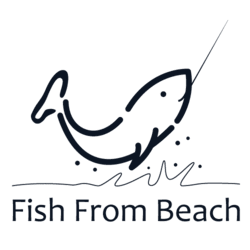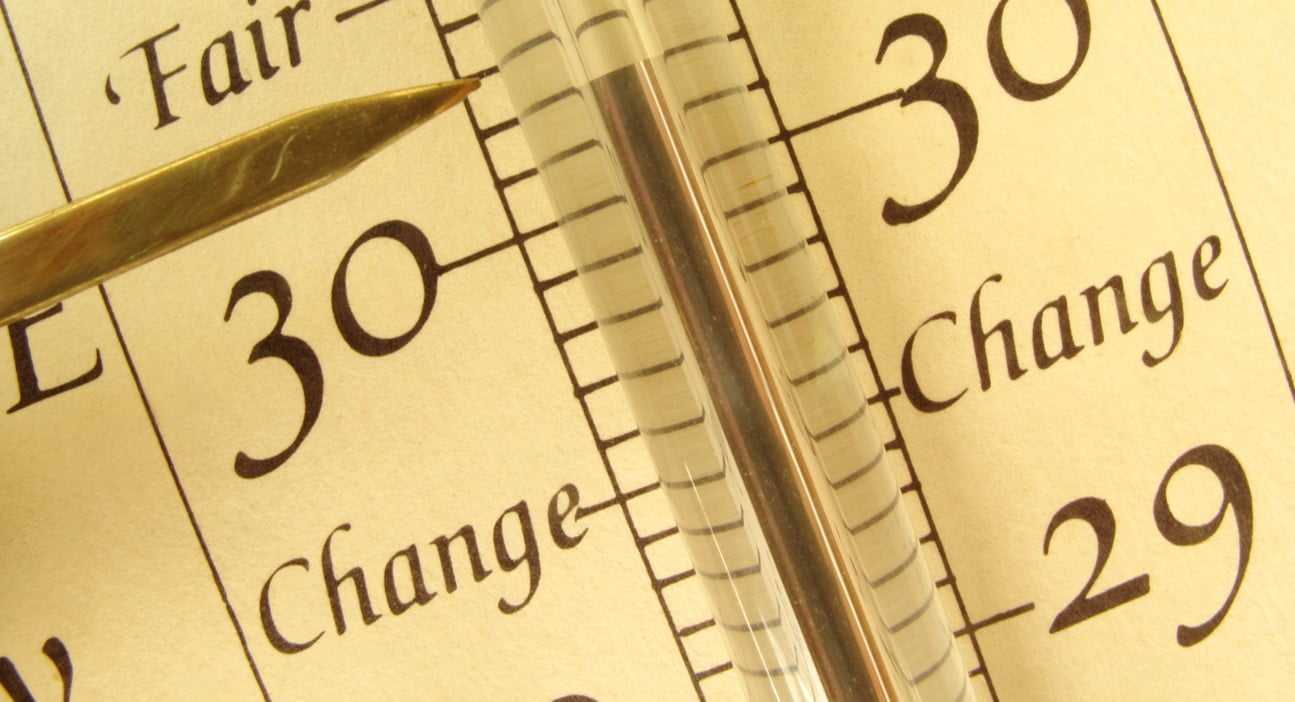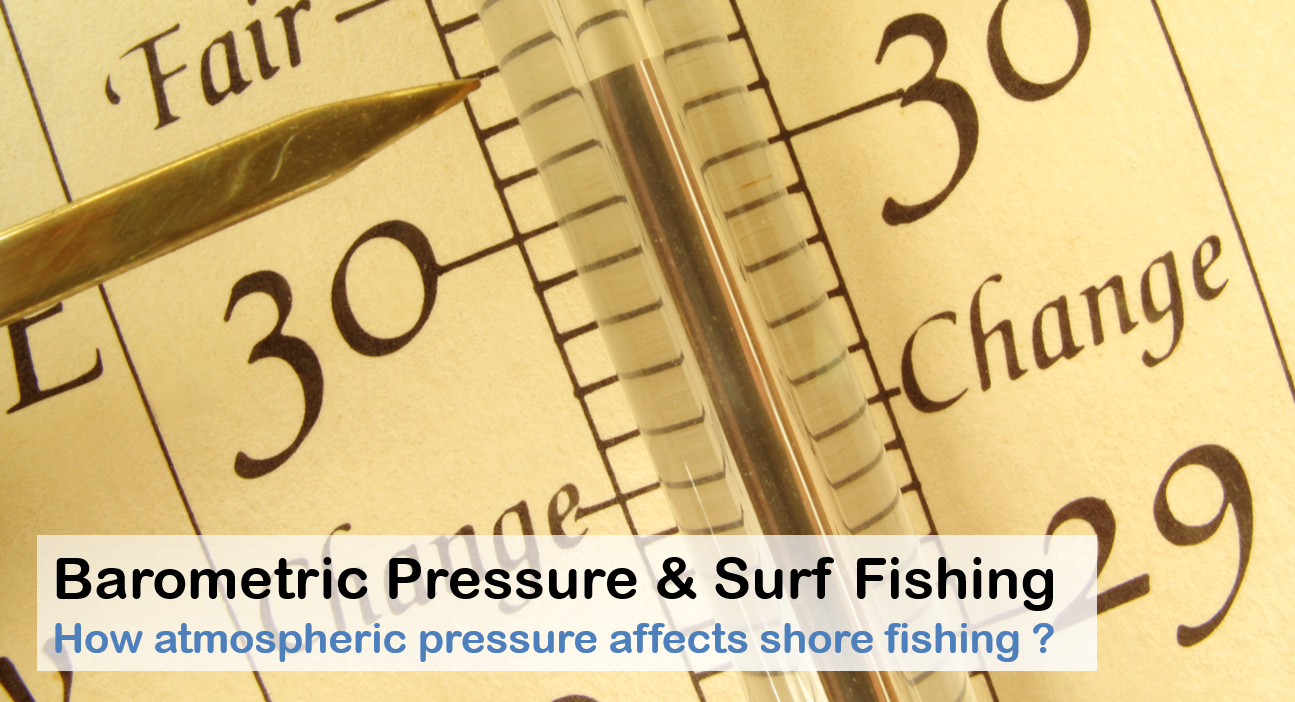The barometric pressure is an important factor to consider if you want to maximize your surf fishing rewards.
Most fish species, especially those living near the shore or in shallow waters, are very sensitive to barometric fluctuations and their feeding habits are strongly affected by the atmospheric pressure.
On the one hand, this relationship is direct because the pressure affects the fish bladder and therefore their feeding habits, and on the other hand, it is indirect, because the barometric changes imply also climatic changes which are known to have a significant impact on the fish bite.
So, how does the barometric pressure affect fishing, particularly surf fishing ? And what is the optimal atmospheric pressure for shore fishing ?
In order to answer these two questions, I did some deep researches on the web and tried to summarise my own fishing experience and that of my fishing friends.
Here is what I come up with…
Nearshore fish feed less when the barometric pressure is at its lowest or highest levels. As a result, you are most likely to experience the highest bites count when the pressure is shifting up or down as the fish will try to eat aggressively during this time in order to prevent starvation once the pressure is bad (very high or very low).
In this article, we will dive deeper into the cause-and-effect relationship between the barometric pressure and surf fishing and thus conclude the best time to hit the beach for some bream, drum or bluefish.
What does the barometric pressure mean ?
The barometric pressure (also called the atmospheric pressure and air pressure) simply means the force exerted by the air’s weight over a certain area.
The instrument we use to measure this force is a mercury-based instrument called the Barometer and the unit we use to refer to the barometric pressure is usually the inHg (inches of mercury).
When the reading on your barometer goes up or down, it means that the weather conditions in your location are changing.
As a general rule, a rise in barometric pressure implies improving weather conditions and a calm and dry climate to come.
Conversely, decreasing barometric pressure means an upcoming wet, cloudy, and windy weather.
In other words, high air pressure is generally associated with sunny and clear skies, while low air pressure is usually associated with winds, rain, and murky skies.
Since we are talking about surf fishing, what concerns us the most is the air pressure at sea level and its impact on beaches and their surrounding environment and weather.
As per the Britannica Encyclopedia, the standard barometric reading at sea level is about 29.92 InHg, but other sources assume pressures between 29.85 and 30.00 InHg to be normal on the beach. Therefore, any measurement above or below this range is considered high or low atmospheric pressure respectively.
Generally speaking, the atmospheric pressure at sea level usually fluctuates between 28.50 and 30.70 inHg. However, the pressure can get as low as 27.25 inHg and that’s usually associated with very bad weather and hurricane-like conditions.
In the following paragraphs, we will discuss what a surf angler should expect when the atmospheric pressure is :
- Within the normal range (between 29.85 and 30.00 inHg)
- High (between 30.00 and 30.70 inHg)
- Low (anything under 29.85)
How barometric changes affect fish feeding habits ?
The question we should first ask is whether the fish are able to feel atmospheric pressure or not ?
The simple and quick answer to this is a big YES.
The fish are able and conditioned to detect barometric changes and they do so using their swim bladders.
A swim bladder (also called air bladder and gas bladder) is a gas-filled organ that most fish species use in order to remain in a particular water depth without the need to swim.
It’s a very important organ for fish because it allows them to conserve energy and save it for more survival tasks such as pursuing prey and escaping predators.
That’s clear. But how does this air bladder allow fish to feel barometric changes ?
As the surrounding air pressure drops, the swim bladder of fish receives less external weight. Consequently, it inflates and gets bigger telling the fish that the pressure is going down.
In the same way, when the barometric pressure increases, the bladder receives more force from the surrounding environment, and thus, it shrinks and gets smaller indicating an increase in atmospheric pressure.
In general, fish species with larger bladders are the most affected by barometric changes. However, as these species are predators and prey of other fish, we can confidently consider that the entire food chain and all fish species are directly or indirectly affected by the atmospheric pressure.
OK, I understand. But how is all this related to surf fishing? what does fishing have to do with a large or small bladder ?
Very good question. In order to answer this, we will discuss both cases.
How does low-pressure impact fish ?
As we said earlier, a weak air pressure exerts less force on the swim bladder causing it to expand and get larger.
As theories claim, an expanded bladder puts extra pressure on the other organs and this can be so uncomfortable for fish.
In order to relieve this discomfort, fish move to deeper waters in search of a higher atmospheric pressure so they can get their bladder to the normal size and thus free their other organs from the extra pressure.
That’s why you should expect less fish nearshore when the air pressure is low (lower than 29.85 inHg).
During this time, fish must be in deeper areas where their bladders get compressed to a comfortable size.
Even if a fish stays within your casting range, an inflated bladder will make it uncomfortable to eat and strike your bait.
Another way low air pressure affects fish is simply the poor weather conditions associated with a low barometer.
Storms accompanied by strong winds, thunder and heavy rain frighten the fish and force them to escape offshore or remain in cover until the storm moves away.
On top of that, choppy weather conditions often cause the water temperature to drop to a low degree that fish are not conditioned to tolerate.
How does high-pressure impact fish ?
Generally speaking, fish prefer high over low barometric pressure. Why ? Well, obviously because a high pressure makes their bladder smaller and hence improve their comfort.
However, and as we said earlier, high atmospheric pressure is associated with warm, clear and dry weather. As a result, the water temperature can become too hot for fish, forcing them to seek cover or migrate elsewhere in search of cooler waters.
Moreover, a high pressure (more than 30.00 inHg) may lead to crystal clear waters, and that makes fish less comfortable to feed.
Most fish species prefer murky and muddy waters because they provide them with the necessary cover to hide and run from larger predators and to surprise and trick smaller prey.
How barometric pressure affects surf fishing ?
Okay, let’s exploit all this knowledge now and try to determine the best and optimal barometric pressure for surf fishing as well as the most promising days to cast bait from the shore.
In order to come up with the best days, I will first exclude and eliminate the worst ones.
As previously explained, neither high nor low barometric pressure is good for fishing.
High barometric pressure makes the water too hot and too clear for fish to hold and feed near the shore. As a result, high pressure days will generally result in poor catches count.
Similarly, days with low pressure are not good for surf fishing because they expand the fish bladders and force them to escape the surf zone to deeper areas with higher atmospheric pressure.
In addition, the poor weather conditions that accompany low barometric measures make the surf too cold and too unstable for most fish species.
So if the air pressure in your area is too high (more than 30.00 inHg) or too low (less than 29.85 inHg), do not bother to be on the beach as you will probably not catch much fish during that time.
However, there is one benefit that we can draw from low and high pressure days and is that fish do not eat a lot during these days.
So ?
Since the fish do not feed when the barometer reading is high or low, they will try to eat as much as possible before that, and that’s when you should be fishing the surf.
Also, when the barometric pressure turns back to the normal range (29.85 – 30.00 inHg), the fish will try to compensate for the days when they were not allowed to eat, making it a prolific time for shore fishing.
Your role as a surf angler is then to spot the days where the barometric pressure starts moving in and out from the normal range and plan your surf fishing trips accordingly.
In the following paragraphs, we will discuss all possible scenarios and dive deeper in that relationship between surf fishing and the barometric pressure.
Normal pressure to low pressure :
This is the best time for shore fishing, especially during the first pressure drops.
When the air pressure begins to fall slowly from the normal range, the fish feel that and know that the coming days may be so bad. As a result, they get stressed and start to eat aggressively in order to secure a sufficient nutritional reserve in case the atmospheric pressure gets too low.
How to predict that ? Just watch the weather forecasts.
When stormy days are ahead, it means that the air pressure will start to drop very soon, generally 24 to 36 hours prior to that.
Low pressure to normal pressure :
Once the pressure starts to rise from low to normal measures, the weather gets better and the water becomes calmer and warmer.
This is a sign to fish that they can approach the shore once again and get back to their normal feeding activity. Therefore, you should experience increased bites count whenever the barometer recovers from low measures.
However, fish may take some time before ensuring that the atmospheric pressure won’t go down again.
Also, they may spend few hours traveling from offshore to coastal areas, and it may take time for them to adjust to the new pressure before they start searching for food.
So after a stormy weather, wait for a couple days before returning to the beach.
The best part about post-storm fishing is that you will throw bait to predators that have not eaten for a long time… and that’s all you need for a prolific day.
Steady normal pressure
When the atmospheric pressure stagnates in the normal range for several days, surf fishing remains productive but attracting fish becomes challenging.
I mean that fish won’t bite as much as after or before a storm, but they will hit when an appetizing bait passes by.
This is when your skillset as a surf angler gets tested.
Fish are no longer forced to eat, and thus, you should use tricks and skills other than relying on the air pressure in order to convince them to strike your baits.
Targeting the structures and weed areas, improving bait presentation, optimizing the tackle and testing a variety of baits are all things that you can do in order to have more bites during normal pressure days.
Normal pressure to high pressure :
When the pressure starts to rise above the normal range (more than 30.00 inHg), there is generally no noticeable impact in terms of fishing.
Fish will continue to hold and feed nearshore, and even if you experience less or more catches, you will have a hard time blaming or crediting pressure. Why ? Simply because you would have no idea that the pressure is rising 😀
We are talking about increments of 0.1 inHg. It’s not humanly possible to detect that without looking into a barometer.
However, once the pressure approaches the 30.50 inHg mark, it becomes clear that the barometric pressure is making surf fishing difficult.
When the weather gets hot and dry, the sunlight bright, the water clear and warm and the surf calm and quiet, fish go off the bite and seek cover or migrate to the open sea in search of cooler waters.
High pressure to normal pressure :
As the pressure falls back to the normal range, the water in the surf zone gets cooler, telling the fish that it’s time to leave the shelter and look for food.
It’s a good time to target the surf because you will meet hungry fish that probably did not eat for a while.
Rapid fluctuations between high and low
Rapid fluctuations from high and low pressure are generally bad for surf fishing because fish won’t have enough time to adjust and thus they will get stressed and eat less.
During quick ups and downs, most fish species migrate offshore for a more stable atmospheric pressure and will not approach the shore until the barometer remains in the normal range for several days.
Summary
Slowly falling atmospheric pressure is the best time to fish from shore. The drop in the barometer implies bad weather conditions to come. As a result, the fish get stressed and eat more out of fear of starvation once the weather makes it hard for them to find food.
A rising pressure can also be beneficial because it means that the weather conditions are improving and the fish are getting more comfortable to feed, especially if the barometer was low for a long time and the fish didn’t enjoy a meal for a while.
Normal or standard pressure days are also good to fish the surf but you need to try different baits and spots during those days. Why ? Because a steady barometric pressure means that fish were feeding normally for a while, and thus, they are less hungry and will only strike when the food is attractive and safe to pursue.
Finally, strong high pressure and low pressure are the worst barometric measures for surf fishing. The fish get uncomfortable to eat during these times and thus become less willing to hit your offerings.
All that being said, the atmospheric pressure is not the only factor to watch if you want to improve your surfcasting productivity.
The water temperature, the time of the day, the season, the tide, the targeted species, the wind direction, the surf conditions, the fishing equipment, the beach structure… are all critical variables in the formula of surf fishing success.
Optimizing these factors along with the barometric pressure is the only way to maximize your results from the shore.
For this purpose, I invite you to read these few articles about each of the factors above :
- Best time of the day to fish the surf
- The optimal water temperature for surf fishing
- Where to cast when surf fishing
- Is rain good for shore fishing
- The best tide for surf fishing
Some recommended surf fishing gear(*)
Note (*): If you make a purchase through links from this website, we may get a small share of the sale from Amazon or other similar affiliate programs.
Surf Fishing Survey
Help us provide you with better content by answering simple questions about your surf fishing experience and knowledge.
We will put the collected responses together and turn them into valuable information that will help you catch more fish from shore 😉
Note: No personal information will be collected with your answer.



